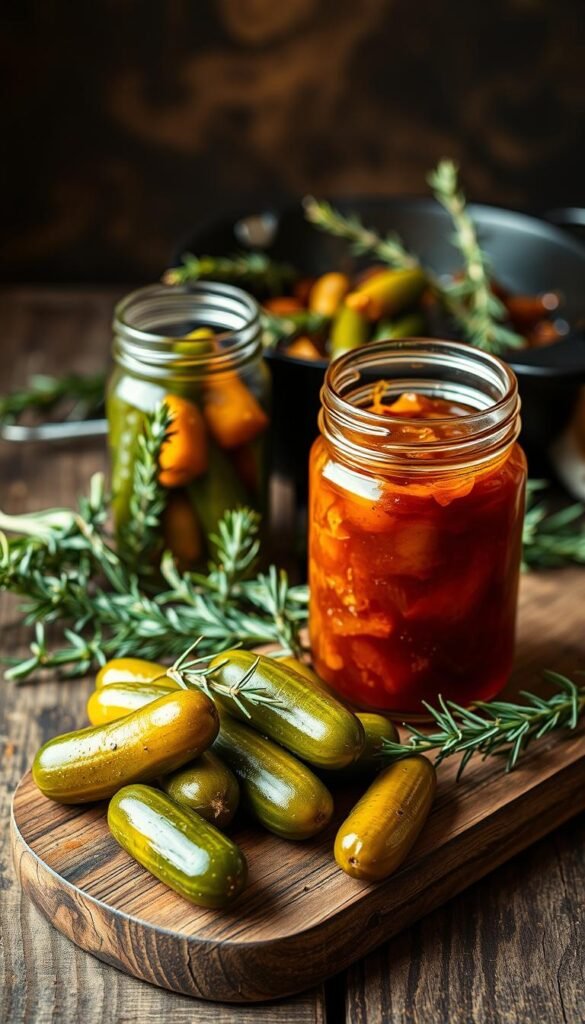11 Creative Ways to Use Rosemary in Cooking
Rosemary comes from the Mediterranean. It has a pine-like smell and strong taste. It makes food go from good to great.
Using rosemary in cooking changes how you see food. You can make oils and even desserts with it. It’s not just for meat and potatoes. Try creative rosemary recipes to make your cooking better.
Key Takeaways
- Discover new rosemary uses beyond traditional dishes.
- Learn how to incorporate rosemary into sweet and savory preparations.
- Explore creative rosemary recipes to enhance your cooking.
- Understand the versatility of rosemary in various culinary contexts.
- Maximize the potential of rosemary in your kitchen with simple techniques.
The Aromatic Power of Rosemary
Rosemary is more than just a flavor booster. It connects us to the Mediterranean’s rich food history. It’s loved for its pine-like smell and can be used in both savory and sweet dishes.
Origins and Varieties of Rosemary
Rosemary comes from the Mediterranean, where it’s been grown for ages. There are many types of rosemary, each with its own special traits. ‘Tuscan Blue’ grows upright and tastes strong. ‘Arp’ is better in cold weather and tastes milder.
‘Prostratus’ is great for hanging baskets and ground cover. ‘Barbecue’ has a strong smell and taste. Knowing these types helps cooks pick the best rosemary for their recipes.
| Rosemary Variety | Growth Habit | Culinary Use |
|---|---|---|
| Tuscan Blue | Upright | Roasted meats, herb-infused oils |
| Arp | Upright | Soups, stews, and as a tea |
| Prostratus | Creeping | Garnishes, herb-infused vinegars |
Flavor Profile and Aromatic Properties
Rosemary tastes like pine because of special compounds. Its flavor can be bitter or sweet, depending on how it’s cooked. Heat brings out its scent, making it great for roasted meats and stews.
Health Benefits of Cooking with Rosemary
Cooking with rosemary adds flavor and nutrition. It’s full of antioxidants that fight stress and inflammation. It also helps your brain and has anti-inflammatory effects.
Adding rosemary to meals makes them healthier and tastier. It’s a great way to improve any dish.
1. Infusing Oils and Vinegars with Rosemary
Infusing oils and vinegars with rosemary is easy and fun. It lets you keep rosemary’s flavor and smell all year. You can use it in many dishes.
Creating Rosemary-Infused Olive Oil
Start with fresh, good-quality rosemary sprigs. For cold infusion, mix rosemary with olive oil in a clean jar. Use 1 cup of olive oil to 1/4 cup of rosemary.
Put the jar in a cool, dark place for 2-4 weeks. Shake it every day. For hot infusion, warm the oil and rosemary gently. Don’t heat the oil too much to avoid botulism.
Strain the oil through cheesecloth or a coffee filter into a clean bottle.
Rosemary Vinegar for Dressings and Marinades
Rosemary vinegar is great for dressings, marinades, and more. Mix white wine vinegar or apple cider vinegar with rosemary in a jar. Use 1 cup of vinegar to 1/4 cup of rosemary.
Let it infuse for at least 2 weeks, shaking it sometimes. Strain and store it in a cool, dark place.
Storage Tips and Shelf Life
Keep rosemary-infused oils and vinegars in clean, dark glass bottles. Store them in a cool, dark place. Rosemary-infused oil lasts 6-12 months. Vinegar can last up to 2 years or more.
Always check for spoilage before using. Look for off smells or mold.
2. Crafting Rosemary Butter and Compound Spreads
Discover the magic of rosemary compound butter. It’s a game-changer for making dishes better with little effort. It mixes butter’s richness with rosemary’s scent, making meals more delicious.
Basic Rosemary Butter Recipe
To make basic rosemary butter, start with soft unsalted butter. Add finely minced fresh or dried rosemary. For fresh, use 1 tablespoon per 1/2 cup butter. For dried, use 1 teaspoon per 1/2 cup butter.
Tips for Preparation: Mix rosemary into butter with a fork until it’s well mixed. For a smoother texture, blend in a food processor.
Savory Rosemary Compound Butter Variations
Try different flavors to make unique compound butters. Some ideas include:
- Rosemary-garlic-lemon butter: Mix in minced garlic and lemon zest for a bright, savory flavor.
- Rosemary-black pepper butter: Add freshly ground black pepper for a spicy kick.
- Rosemary-honey butter: Incorporate honey for a sweet and savory contrast.
Serving Suggestions and Pairings
Use rosemary compound butter in many ways. Melt it over grilled steaks, spread it on warm bread, or finish pasta dishes. It’s great with roasted veggies and makes instant pan sauces. It’s a handy trick for adding complex flavors to simple dishes.
Try different pairings and uses to find your favorite ways to use rosemary compound butter.
3. Making Rosemary Salt and Finishing Seasonings
Elevate your dishes with the aromatic flavor of rosemary. Make your own rosemary salt and finishing seasonings at home. These condiments add depth and complexity to many dishes.
Homemade Rosemary Salt Blend
To make rosemary salt, mix dried rosemary with salt. Use kosher, sea salt, or flaky finishing salts. Start with 1 tablespoon of dried rosemary for 1 cup of salt. You can dry fresh rosemary by hanging it upside down or using a dehydrator.
Tips for preparing rosemary salt:
- Grind rosemary into a fine powder before mixing it with salt.
- Mix the rosemary and salt in a bowl until well combined.
- Store the rosemary salt in an airtight container to keep its flavor and aroma.
Rosemary Pepper and Other Spice Combinations
Rosemary can be mixed with other spices for unique flavors. Some ideas include:
- Rosemary-lemon pepper: Mix dried rosemary with lemon zest and black pepper.
- Rosemary-garlic salt: Combine dried rosemary with garlic powder and salt.
- Mediterranean rosemary blend: Mix dried rosemary with oregano, thyme, and garlic powder.
Best Dishes for Rosemary Seasonings
Rosemary seasonings are great for many dishes, including:
- Roasted potatoes: Sprinkle rosemary salt over roasted potatoes for added flavor.
- Grilled meats: Use rosemary pepper to add a smoky, aromatic flavor to grilled meats.
- Pasta dishes: Toss cooked pasta with rosemary salt and olive oil for a simple yet flavorful sauce.
By using rosemary seasonings, you can add depth and complexity to many dishes. This includes savory meats and sweet desserts.
4. Creating Rosemary Simple Syrup for Cocktails and Desserts
Adding rosemary to simple syrup opens up new flavors. It’s great for both savory and sweet dishes. This mix of rosemary and sugar makes a unique syrup for drinks and desserts.
Basic Rosemary Simple Syrup Recipe
Start by mixing equal parts water and sugar in a saucepan. Add fresh rosemary sprigs and heat until the sugar dissolves. Use about 1/4 cup of rosemary for every 2 cups of syrup.
Let it steep off the heat for 30 minutes. This lets the rosemary flavor mix well with the syrup. Strain it into a clean bottle and keep it in the fridge.
Tips for Optimal Flavor: Choose fresh, good-quality rosemary. Adjust the steeping time for your taste.
Cocktail Applications
Rosemary simple syrup is great in cocktails. It adds a piney taste that goes well with gin, bourbon, and vodka. Try it in a Rosemary Gin Fizz or a Rosemary Old Fashioned.
For a cool summer drink, mix it with lemonade. This makes a refreshing Rosemary Lemonade.
Sweet Culinary Uses
Rosemary simple syrup is also good for desserts. Brush it on cakes or scones for extra flavor. It’s also great in ice cream bases or fruit compotes.
For a fancy dessert, drizzle it over pastries or use as a glaze. The trick is to balance the rosemary flavor with sweetness. This creates a rich and complex taste.
5. Using Rosemary Smoke for Grilling and Roasting
Learn how to use rosemary to make your grilled and roasted foods taste better. This method lets you add the herb’s scent to your food without using it as a seasoning.
Using Rosemary Sprigs as Smoking Material
To make rosemary smoke, start with fresh or dried rosemary. It should be a bit wet but not too wet. You can make it damp by soaking dried rosemary in water or using fresh rosemary that’s a bit dry.
For gas grills, wrap the rosemary in foil with holes. This makes smoke packets. For smokers, mix rosemary with wood chips. This will give your food a nice, herb flavor.

Rosemary Skewers for Kebabs
Use rosemary stems as skewers for kebabs. Pick strong stems and remove most leaves to avoid burning. Soak them in water to keep them from catching fire.
Put your favorite foods like lamb, chicken, or veggies on the skewers. As they grill, the rosemary adds a great smell to your food.
Flavor Profile of Rosemary-Smoked Foods
Rosemary-smoked foods taste different from those seasoned with rosemary. The smoke adds a soft, aromatic flavor. It’s great for grilled meats, roasted veggies, and some seafood.
Using rosemary smoke in your cooking makes your dishes more interesting. It adds a new layer of taste that’s both complex and tasty.
6. Preparing Rosemary-Infused Honey and Syrups
Infusing honey with rosemary makes a special sweetener. It’s good for both savory and sweet dishes. To make it, mix high-quality honey with fresh or dried rosemary sprigs.
Making Rosemary Honey at Home
Start by picking a good honey that goes well with rosemary. Mix 1 cup of honey with 1/4 cup of fresh rosemary or 2 tablespoons of dried rosemary in a clean jar. You can heat it gently or let it sit at room temperature.
After it’s infused, strain the honey through a fine-mesh sieve or cheesecloth. Put the rosemary honey in an airtight container. It gets better with time, so make it early.
Savory Applications for Rosemary Honey
Rosemary honey is more than just a sweetener. It’s great for savory dishes too. Use it as a glaze for roasted veggies or on cheese boards. It’s also good in vinaigrettes or as a marinade for meats.
| Savory Dish | Rosemary Honey Application |
|---|---|
| Roasted Vegetables | Glaze or drizzle |
| Cheese Board | Topping |
| Vinaigrette | Ingredient |
Sweet Pairings and Dessert Ideas
Rosemary honey is also great for desserts. Drizzle it over ice cream or yogurt. It’s also good in fruit compotes or baked goods.
When using rosemary honey in desserts, start with a little. The flavor is strong. This makes your dessert special with a hint of herbal taste.
7. 11 Creative Ways to Use Rosemary in Cooking
Rosemary can make your cooking special. It adds new flavors to dishes. This turns simple meals into amazing ones.
Rosemary in Unexpected Dishes
You can use rosemary in many dishes. Try rosemary-infused chocolate desserts or rosemary-glazed fruit. It’s all about matching its flavor with others.
Rosemary and lemon make a great rosemary lemonade. It’s refreshing. Or, mix it with garlic for a tasty rosemary roasted potato.
| Dish | Rosemary Pairing | Flavor Profile |
|---|---|---|
| Chocolate Desserts | Rosemary Infusion | Herbaceous, slightly bitter |
| Grilled Meats | Rosemary Sprigs | Smoky, aromatic |
| Fruit Salads | Rosemary Leaves | Piney, refreshing |
Balancing Rosemary’s Potent Flavor
To not overpower dishes, balance rosemary’s flavor. Try bruising rosemary sprigs to release oils. Use whole rosemary leaves for a light taste.
Add rosemary late in cooking to keep its scent. Mix it with garlic, lemon, or olive oil for a good balance.
“The art of cooking is not just about following a recipe; it’s about understanding the harmony of flavors and textures.”
Experimenting with Rosemary in Your Kitchen
Try new things with rosemary. Start with rosemary and olive oil bread or rosemary-infused vinegar. Then, move to rosemary-crusted lamb or rosemary and lemon roasted chicken.
Remember to taste and adjust rosemary as you go. This way, you can find the perfect amount for you.

8. Incorporating Rosemary in Baking: Breads, Cookies, and More
Rosemary adds a piney aroma to baked goods. It’s not just for savory dishes. It also goes well with sweet ingredients.
Savory Rosemary Bread Recipes
Mixing rosemary into bread makes loaves aromatic. For focaccia, add chopped rosemary, olive oil, salt, and garlic. Chop the rosemary finely or use herb-infused oil.
For rustic breads, place a sprig of rosemary on top before baking. It adds flavor and looks good too.
| Bread Type | Rosemary Preparation | Additional Flavor |
|---|---|---|
| Focaccia | Chopped fresh rosemary | Olive oil, garlic |
| Rustic No-Knead | Rosemary sprig on top | Sea salt |
| Dinner Rolls | Rosemary-infused butter | Parmesan cheese |
Sweet Treats with Rosemary
Rosemary pairs well with lemon or honey in sweet baked goods. Try rosemary shortbread by mixing chopped rosemary into butter and sugar. You can also make rosemary and lemon bars or honey cakes.
Balancing Rosemary in Baked Goods
To use rosemary in baked goods, balance its flavor. Infuse rosemary into fats like butter or oil. This spreads its flavor evenly.
When using rosemary in sweets, watch out for its bitterness. Lemon zest or honey can balance it. Start with a little rosemary and add more if needed.
9. Preserving with Rosemary: Pickles, Jams, and Confit
Preserving with rosemary lets cooks keep the herb’s flavor in tasty forms. This includes pickles, jams, and confits. Rosemary’s strong antimicrobial properties make it great for keeping food safe and adding flavor.
Rosemary-Infused Pickles and Preserves
Rosemary pickles and preserves add a special touch to recipes. For example, rosemary quick pickles are a crunchy snack. Rosemary-apple jam and rosemary-citrus marmalade are great on toast or as a meat glaze.
- Rosemary quick pickles
- Rosemary-apple jam
- Rosemary-citrus marmalade
Rosemary Confit Techniques
Making rosemary confit means slow-cooking the herb with other ingredients in oil. This creates rich, preserved foods. You can make rosemary-garlic confit, rosemary-infused tomato confit, and rosemary-preserved lemons. It’s important to use the right oil, cooking temperature, and storage.
| Confit Type | Main Ingredients | Storage Method |
|---|---|---|
| Rosemary-Garlic Confit | Rosemary, garlic, olive oil | Refrigerate in airtight container |
| Rosemary-Infused Tomato Confit | Rosemary, tomatoes, olive oil | Refrigerate or freeze |
| Rosemary-Preserved Lemons | Rosemary, lemons, salt, water | Refrigerate, submerged in brine |
Shelf-Stable Rosemary Creations
For safe and tasty preservation, use proper canning and storage. This includes the right processing times and storage. It’s also important to fix common issues. These preserved items add flavor to everyday meals.

Preserving with rosemary captures the herb’s flavor for all year. It turns simple meals into something special. These pantry staples get better with time, adding depth to dishes.
10. Brewing Rosemary Tisanes, Teas, and Beverages
Rosemary can be turned into tasty and healthy drinks. Its piney taste is great in many drinks. Adding rosemary to your drinks can bring health benefits and new tastes.
Hot and Cold Rosemary Drinks
Rosemary makes many hot and cold drinks. For a warm rosemary tea, put 1-2 teaspoons of fresh or dried rosemary in boiling water. Let it steep for 5-7 minutes. You can add lemon, honey, or herbs like lemon balm or chamomile for extra flavor.
For cold drinks, make a rosemary infusion by soaking rosemary sprigs in cold water for hours or overnight in the fridge.
To make strong rosemary tea, use more rosemary and steep it longer. This tea is great for other drinks or recipes. Try different steeping times and amounts to find your favorite taste.
Rosemary Lemonade and Fruit Infusions
Rosemary goes well with citrus and fruits, making it perfect for lemonades and fruit infusions. For rosemary lemonade, mix lemon juice, sugar, water, and rosemary in a pitcher. Chill it in the fridge for 30 minutes to mix the flavors well. You can also mix rosemary with fruits like peaches or berries for unique tastes.
Make a rosemary-peach iced tea by steeping rosemary and peach tea bags in hot water, then cool it with sliced peaches. Or, try a rosemary-berry spritzer by mixing rosemary water with sparkling water and fruit juice.
Health Benefits of Rosemary Beverages
Rosemary drinks may help with digestion and reduce inflammation. They also have antioxidants that protect cells and support health. While they’re not a magic cure, they’re a healthy choice.
Drinking rosemary beverages might also help your brain and memory. But, always talk to a doctor before using rosemary for health reasons.
11. Creating Rosemary Ice Cubes and Frozen Preparations
Rosemary ice cubes are great for adding fresh flavor to drinks and recipes all year. They keep the herb’s taste and smell fresh. This makes it easy to use in soups, desserts, and more.

Rosemary-Infused Ice for Beverages
Making rosemary ice cubes is easy. Just mix fresh rosemary with water in an ice cube tray. Use cooled boiled water for clear ice. You can also add lemon slices or flowers for extra flavor.
Clear rosemary ice is great for drinks. It keeps the flavor without watering it down.
- Combine fresh rosemary sprigs with water in an ice cube tray.
- For a stronger flavor, use a higher ratio of rosemary to water.
- Experiment with adding citrus slices or other herbs for unique flavor combinations.
Freezing Rosemary in Oil for Long-Term Storage
Freezing rosemary in oil is a good way to keep it fresh for a long time. Mix chopped rosemary with oil like olive or grapeseed. Then, freeze it in airtight containers or ice cube trays.
Rosemary oil cubes are perfect for cooking. They add fresh rosemary flavor to many dishes.
- Mix chopped rosemary with oil in a bowl.
- Pour the mixture into ice cube trays or airtight containers.
- Freeze until solid, then transfer to a freezer-safe bag for long-term storage.
Rosemary Ice Cream and Frozen Desserts
Rosemary can also make unique frozen treats. Rosemary ice cream is a tasty mix of herb and sweetness. Try making rosemary granitas, sorbets, and semifreddos for different textures and tastes.
- Combine rosemary with cream, sugar, and other desired ingredients to make ice cream.
- Experiment with different sweeteners, like honey, to complement rosemary’s flavor.
- Use rosemary in sorbet or granita recipes for a refreshing dessert.
Conclusion: Embracing Rosemary’s Versatility in Your Kitchen
Rosemary makes many dishes better, like roasted meats and baked goods. We talked about using rosemary in many ways. This includes making oils, vinegars, butters, and seasonings.
Adding rosemary to your cooking can make dishes more interesting. It’s great for both experienced cooks and beginners. Knowing how to use rosemary is key to making it work well in your food.
Grow your own rosemary to always have some. You can do this outdoors or in pots inside. Learning how to harvest and store rosemary will keep its taste and smell good.
Keep trying new things with rosemary. You’ll find dishes and ways to cook that you love. Using rosemary in your cooking will open up a world of flavors and ideas.






